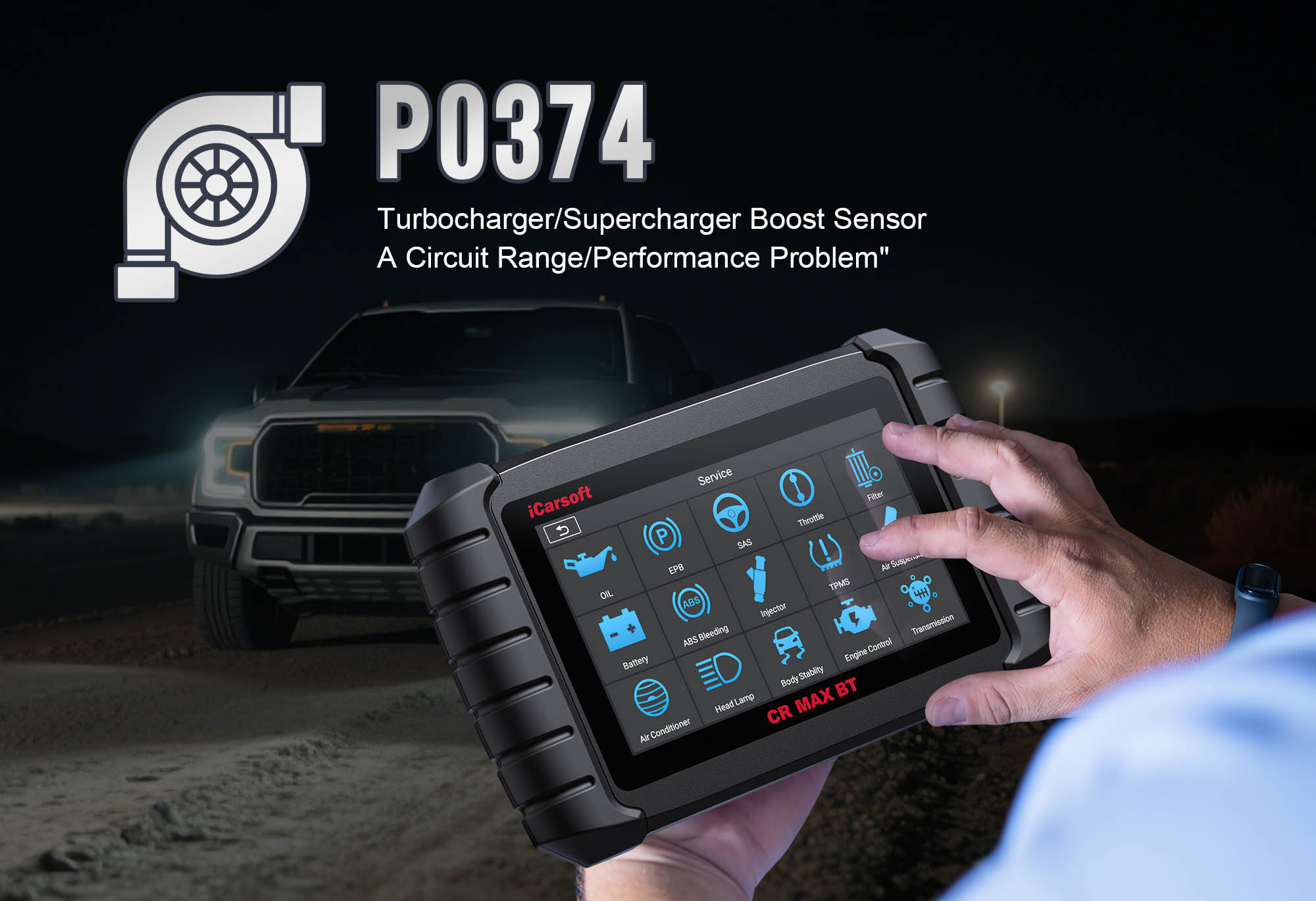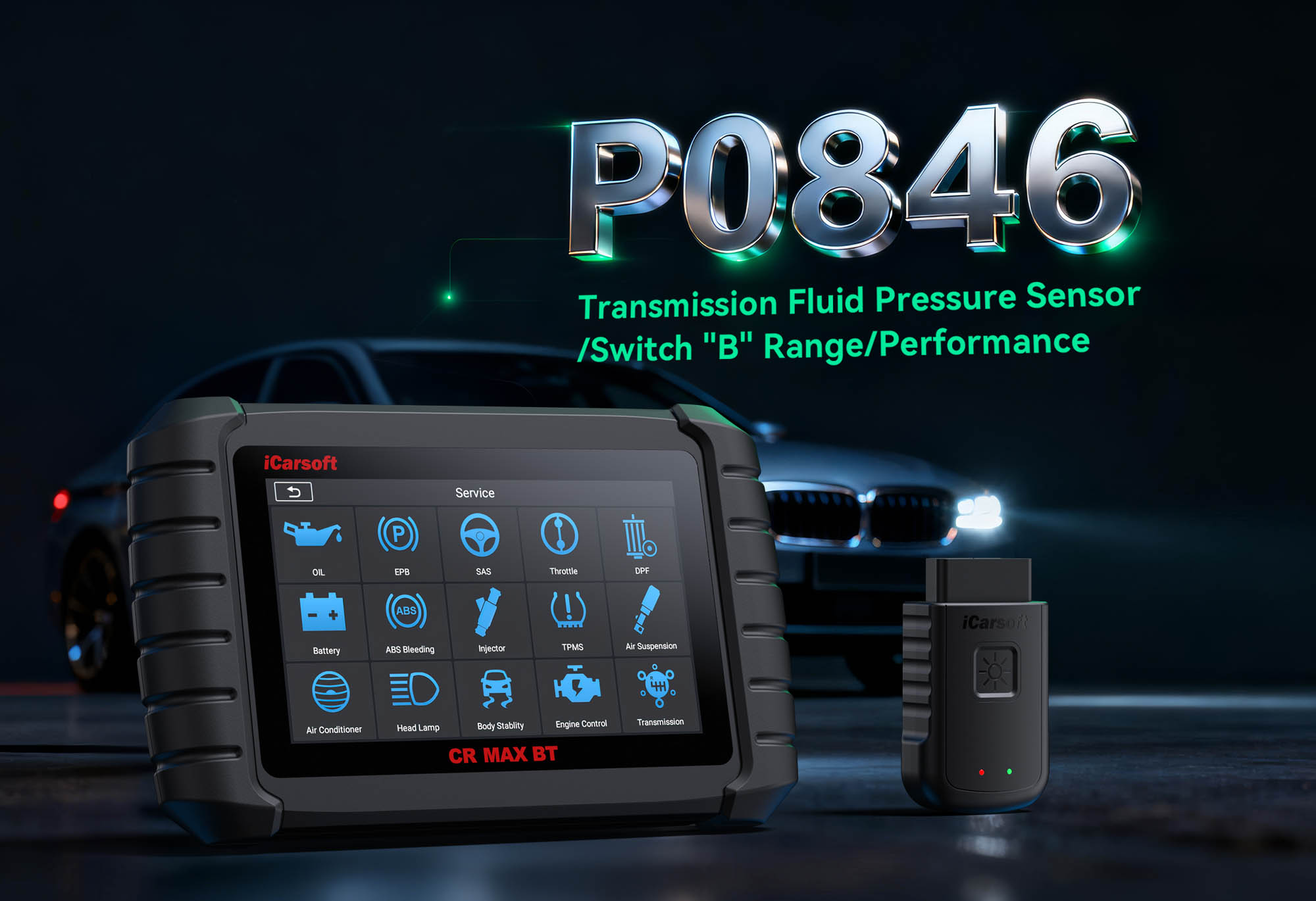Understanding OBD-II Code P0374: Causes, Symptoms, and CR MAX BT Diagnostic Solution
When your vehicle’s dashboard illuminates the Check Engine Light and you retrieve P0374 — defined as "Timing Reference High-Resolution Signal A Intermittent/Erratic Pulse" — it signals a critical issue: the Engine Control Module (ECM) is receiving inconsistent timing data from the crankshaft or camshaft position sensor. This timing reference is non-negotiable for accurate ignition timing, fuel injection sync, and overall engine combustion—ignoring P0374 can lead to worsening performance and costly damage.
1. What Does P0374 Mean?
Error code P0374 focuses on timing reference signal anomalies, specifically an intermittent or erratic pulse from the "High-Resolution Signal A" (typically linked to the crankshaft position sensor, though some vehicles tie it to the camshaft sensor). Here’s a technical breakdown:
-
Timing Reference Signal: The ECM relies on this signal to track the crankshaft/camshaft’s rotation speed and position—this data dictates when to fire spark plugs and inject fuel.
-
High-Resolution: Unlike basic timing signals, this high-precision signal provides detailed, frequent pulses (often hundreds per rotation) for precise combustion control in modern engines.
-
Intermittent/Erratic Pulse: The signal drops out, fluctuates unexpectedly, or doesn’t match the ECM’s expected pattern—causing the module to lose sync with engine movement.
Without a steady timing reference, the ECM can’t optimize ignition or fuel injection. This doesn’t just hurt performance—it can trigger "limp mode" (to protect the engine) or even cause stalling in severe cases.
2. Common Causes of P0374
P0374 rarely occurs randomly; it’s almost always tied to a physical or electrical issue with components that generate or transmit the timing signal. Mechanics and DIYers most often pinpoint these root causes:
Faulty Crankshaft/Camshaft Position Sensor
The sensor itself is the most common culprit—wear or damage disrupts signal generation:
-
Internal component failure (e.g., faulty magnetic pickup or circuitry).
-
Heat damage (prolonged exposure to engine heat degrades sensor materials).
-
Contamination (oil, dirt, or debris covering the sensor’s tip, blocking pulse detection).
Damaged Wiring & Connectors
Even a working sensor can’t send a steady signal if wiring is compromised:
-
Frayed, cut, or chafed wires (expose conductors, causing short circuits or signal loss).
-
Corroded or loose connectors (moisture and oxidation block electrical flow between the sensor and ECM).
-
Electromagnetic interference (EMI) from nearby ignition components (spark plugs, coils) distorts the signal.
Worn or Misaligned Timing Components
Timing system issues throw off the sensor’s ability to track rotation:
-
Stretched or broken timing belt/chain (causes crankshaft-camshaft misalignment, shifting the signal pattern).
-
Worn timing gears (excessive play disrupts consistent rotation).
-
Misaligned sensor mounting (the sensor is too far from the reluctor wheel, weakening the signal).
ECM Software Glitches or Module Failures
Rare but possible—issues with the ECM itself can mimic signal problems:
-
Outdated ECM firmware (fails to recognize normal signal variations, flagging false errors).
-
Internal ECM circuitry failure (can’t process or interpret the timing signal).
-
Power supply issues (low voltage to the ECM disrupts signal reception).
3. Symptoms to Watch For
P0374 symptoms vary based on how severe the signal disruption is—some are subtle, while others make driving nearly impossible. Be alert for these warning signs:
Key Symptoms of P0374
-
Check Engine Light Illumination: The earliest and most consistent sign—use a scan tool like the CR MAX BT to confirm P0374 (it may appear with related codes like P0335, P0340, or P0300).
-
Engine Misfires & Rough Idling: Inconsistent timing causes incomplete combustion—you’ll feel shaking at idle or "sputtering" during acceleration.
-
Sudden Stalling or Difficulty Starting: Severe signal loss means the ECM can’t sync ignition— the engine may stall while driving or crank but not start.
-
Reduced Fuel Efficiency & Sluggish Performance: The ECM compensates for bad timing by over-fueling or delaying ignition—this lowers MPG and makes acceleration feel "sluggish."
-
Limp Mode Activation: To protect the engine, the ECM limits RPM (often to 2,000–3,000) and power—this prevents further damage but makes highway driving unsafe.
Note: Symptoms may be intermittent (e.g., appearing only when the engine is warm) if the issue is a loose wire or partially failing sensor.
4. Scan, Diagnose, and Fix with CR MAX BT
Diagnosing P0374 without the right tool leads to guesswork (and costly part swaps). The iCarsoft CR MAX BT—a powerful Bluetooth OBD-II diagnostic scanner—streamlines troubleshooting by focusing on the root cause, not just the code. Here’s how to use it to resolve P0374:
-
Step 1: Connect & Retrieve Code + Freeze-Frame Data
-
Plug the CR MAX BT into your vehicle’s OBD-II port (under the dashboard) and power it on. Pair it with your phone/tablet via Bluetooth.
-
Select your vehicle using Auto VIN Detection (no manual make/model entry needed) and navigate to Engine > Fault Codes > Read Codes to confirm P0374.
-
Access Freeze-Frame Data—this records engine conditions (RPM, temperature, load) when P0374 triggered, helping you replicate the issue during testing.
-
Step 2: Monitor Live Timing Signal Data
-
Go to Engine > Live Data > Timing System and add these parameters to your "Favorites" for easy tracking:
-
Crankshaft Position Sensor Signal (Hz/pulses per second)
-
Camshaft Position Sensor Signal (Hz/pulses per second)
-
Timing Reference Signal Voltage (V)
-
ECM Timing Advance (degrees)
-
Start the engine (only if no stalling risk) and let it idle for 2 minutes. Then accelerate slowly to 2,500 RPM while monitoring:
-
Erratic Signal Confirmation: Signal frequency/voltage drops out, spikes, or doesn’t match RPM (e.g., RPM increases but signal stays flat) → Issue is sensor/wiring.
-
Steady Signal: Signal is consistent but ECM still flags P0374 → Issue is ECM firmware or module.
-
Step 3: Inspect Sensor & Wiring (Guided by CR MAX BT)
-
Use the CR MAX BT’s Component Location feature to find the crankshaft/camshaft sensor (varies by vehicle).
-
With the engine off and battery disconnected, inspect:
-
Sensor: Check for physical damage, contamination, or loose mounting. Use the CR MAX BT’s Sensor Resistance Test (under Special Functions) to verify sensor health (normal resistance: 800–1,500 ohms).
-
Wiring: Look for fraying, corrosion, or EMI sources (wiring too close to ignition coils). Use the scanner’s Circuit Test to check for shorts or open circuits.
-
Step 4: Validate Timing Components
-
If sensor/wiring check out, use the CR MAX BT’s Timing Sync Test (under Special Functions > Engine) to compare crankshaft and camshaft rotation—misalignment here points to timing belt/chain issues.
-
For visual confirmation: Remove the timing cover (if accessible) and check for stretched belts, worn gears, or loose components. Consult your vehicle’s service manual for torque/sync specs.
-
Step 5: Resolve ECM Issues (If Needed)
-
If all mechanical/electrical checks pass, use the CR MAX BT to run an ECM Firmware Check—outdated software often causes false P0374 codes. The scanner can guide you through firmware updates (if supported).
-
If updates fail, the ECM may need replacement—this requires professional programming (the CR MAX BT can link to certified shops for support).
By following this process—known as "P0374 diagnosis using CR MAX BT"—you’ll avoid replacing unnecessary parts (e.g., a new ECM when the issue is just a corroded wire) and resolve the code efficiently.
5. Fixing the P0374 Code
Once you’ve diagnosed the root cause with the CR MAX BT, use these targeted fixes to resolve P0374. Prioritize lower-cost, simpler repairs first to minimize spending:
Replace Faulty Crankshaft/Camshaft Sensor
-
Disconnect the vehicle’s battery (negative terminal first) to avoid electrical shorts.
-
Remove the old sensor (use a socket wrench for bolted sensors; gently pull for clip-on models).
-
Clean the mounting area and install a high-quality OEM/aftermarket sensor (avoid generic parts—they often fail quickly).
-
Reconnect the battery and use the CR MAX BT to clear P0374.
Repair or Secure Wiring/Connectors
-
Cut out frayed/chafed wire sections and splice in matching-gauge wire (use heat-shrink tubing to seal connections).
-
Clean corroded connectors with electrical contact cleaner and apply dielectric grease to prevent future corrosion.
-
Reroute wiring away from ignition components (use zip ties to secure it to a non-heat-sensitive area) to eliminate EMI.
Adjust or Replace Timing Components
-
For stretched timing belts/chains: Replace with a manufacturer-approved kit (include tensioners and idlers for full repair).
-
For misaligned sensors: Loosen the sensor mount, adjust its position to match factory specs (use CR MAX BT’s Signal Strength Test to verify), and retighten.
-
For worn timing gears: Replace gears and reset timing per your vehicle’s service manual.
Reprogram or Replace the ECM
-
First, reprogram the ECM with the latest firmware using the CR MAX BT (follow on-screen prompts—requires a stable internet connection).
-
If reprogramming fails, replace the ECM with a OEM module. Have a certified technician program it to your vehicle’s VIN (critical for compatibility).
6. Preventive Maintenance with CR MAX BT
Avoid future P0374 codes with proactive maintenance—made easier with the CR MAX BT. Incorporate these steps into your vehicle care routine:
Proactive P0374 Prevention Tips
-
Regular Timing Signal Scans: Use the CR MAX BT to run Timing System Health Checks (under Quick Tests) every 5,000 miles. This flags subtle signal issues before they trigger P0374.
-
Sensor & Wiring Inspections: Pair scans with visual checks—use the CR MAX BT’s Component Location to quickly find sensors and wiring for periodic inspections (look for wear, corrosion, or EMI risks).
-
Timing Component Replacement Reminders: The CR MAX BT lets you set maintenance alerts for timing belts/chains (based on your vehicle’s recommended interval—typically 60,000–100,000 miles).
-
ECM Firmware Updates: Use the scanner to check for ECM updates every 6 months—outdated software is a common cause of false P0374 codes.
These steps—often searched for under "CR MAX BT timing system maintenance"—keep your timing system healthy and prevent unexpected breakdowns.
Summary Table: P0374 Diagnosis & Fixes
|
Diagnosed Issue
|
Recommended Fix
|
CR MAX BT Tool Feature to Use
|
Estimated Cost (DIY vs. Professional)
|
|
Faulty crankshaft/camshaft sensor
|
Replace with OEM/quality aftermarket sensor
|
Sensor Resistance Test, Live Data
|
$50–$150 (DIY) / $150–$300 (Professional)
|
|
Damaged wiring/connectors
|
Repair/replace wires; clean connectors; reroute for EMI
|
Circuit Test, Component Location
|
$10–$50 (DIY) / $100–$200 (Professional)
|
|
Worn/misaligned timing components
|
Replace timing belt/chain; adjust sensor position
|
Timing Sync Test, Signal Strength Test
|
$100–$300 (DIY) / $300–$800 (Professional)
|
|
ECM firmware/module issues
|
Reprogram ECM; replace module if needed
|
ECM Firmware Check, Signal Validation
|
$0 (update, DIY) / $300–$1,000 (module replacement)
|
Final Thoughts
The P0374 code may seem intimidating at first, but with the right knowledge and tools, it’s a problem you can solve on your own. By understanding the code’s causes (sensor, wiring, timing, or ECM issues), following a systematic diagnostic process, and using the iCarsoft CR MAX BT to simplify scans and data analysis, you’ll save time, money, and frustration.
Whether you’re a seasoned mechanic or just learning the ropes, the CR MAX BT is designed to make OBD-II diagnostics accessible and effective. It eliminates guesswork, focuses on root causes, and guides you through every step—from code retrieval to repair verification.
Ready to Tackle P0374?
Grab your iCarsoft CR MAX BT, connect it to your vehicle, and start with a live timing signal scan. Follow the diagnostic steps outlined above to isolate the issue, make targeted repairs, and clear the code. With the CR MAX BT by your side, you’ll get your vehicle back on the road with confidence—no costly dealer visits required.





